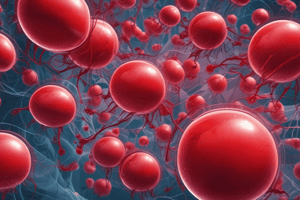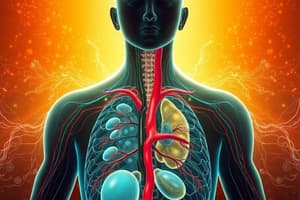Podcast
Questions and Answers
Which of the following statements correctly describes the role of hemoglobin in oxygen transport?
Which of the following statements correctly describes the role of hemoglobin in oxygen transport?
How does the partial pressure of carbon dioxide (CO2) influence its movement from tissues to the lungs?
How does the partial pressure of carbon dioxide (CO2) influence its movement from tissues to the lungs?
Which of the following factors would not affect the oxygen-carrying capacity of hemoglobin?
Which of the following factors would not affect the oxygen-carrying capacity of hemoglobin?
What is the primary mechanism by which carbon dioxide (CO2) is transported in the blood?
What is the primary mechanism by which carbon dioxide (CO2) is transported in the blood?
Signup and view all the answers
How does the oxyhemoglobin dissociation curve shift in response to increased acidity (decreased pH)?
How does the oxyhemoglobin dissociation curve shift in response to increased acidity (decreased pH)?
Signup and view all the answers
What is the primary reason for the diffusion of oxygen from the alveoli into the blood capillaries?
What is the primary reason for the diffusion of oxygen from the alveoli into the blood capillaries?
Signup and view all the answers
Which of the following statements correctly describes the relationship between the respiratory system and the circulatory system?
Which of the following statements correctly describes the relationship between the respiratory system and the circulatory system?
Signup and view all the answers
What is the role of bicarbonate ions (HCO3-) in carbon dioxide transport in the blood?
What is the role of bicarbonate ions (HCO3-) in carbon dioxide transport in the blood?
Signup and view all the answers
What disease condition can directly reduce the surface area available for gas exchange in the lungs?
What disease condition can directly reduce the surface area available for gas exchange in the lungs?
Signup and view all the answers
Which of the following is NOT directly involved in the process of gas exchange?
Which of the following is NOT directly involved in the process of gas exchange?
Signup and view all the answers
What is the primary role of chemoreceptors in the regulation of breathing?
What is the primary role of chemoreceptors in the regulation of breathing?
Signup and view all the answers
How does anemia impact the efficiency of gas exchange?
How does anemia impact the efficiency of gas exchange?
Signup and view all the answers
Which of the following statements accurately reflects the role of the circulatory system in gas exchange?
Which of the following statements accurately reflects the role of the circulatory system in gas exchange?
Signup and view all the answers
Flashcards
Circulatory System
Circulatory System
Transports oxygen and removes carbon dioxide throughout the body.
Gas Exchange Diseases
Gas Exchange Diseases
Conditions like asthma and pneumonia that impair airflow and gas exchange.
Alveoli
Alveoli
Tiny air sacs in the lungs crucial for gas exchange.
Regulation of Breathing
Regulation of Breathing
Signup and view all the flashcards
Homeostasis
Homeostasis
Signup and view all the flashcards
Oxygen Diffusion
Oxygen Diffusion
Signup and view all the flashcards
Hemoglobin Function
Hemoglobin Function
Signup and view all the flashcards
Oxyhemoglobin Transport
Oxyhemoglobin Transport
Signup and view all the flashcards
Oxygen Release Mechanism
Oxygen Release Mechanism
Signup and view all the flashcards
Carbon Dioxide Transport
Carbon Dioxide Transport
Signup and view all the flashcards
Bicarbonate Formation
Bicarbonate Formation
Signup and view all the flashcards
Gas Exchange Process
Gas Exchange Process
Signup and view all the flashcards
Factors Influencing Gas Exchange
Factors Influencing Gas Exchange
Signup and view all the flashcards
Study Notes
Oxygen (O2) Uptake and Transport
- Oxygen is inhaled into the lungs during respiration.
- In the lungs, oxygen diffuses from the alveoli (tiny air sacs) into the capillaries surrounding them.
- Red blood cells (erythrocytes) contain hemoglobin, a protein that binds to oxygen.
- Oxygen binds reversibly to hemoglobin, forming oxyhemoglobin.
- The concentration gradient of oxygen drives the diffusion process from the lungs to the blood.
- Oxyhemoglobin is transported throughout the circulatory system.
- Oxygen detaches from hemoglobin in tissues with lower oxygen levels.
- This released oxygen diffuses into the tissues, providing the cells with the necessary energy for metabolic processes.
Carbon Dioxide (CO2) Removal and Transport
- Cellular respiration produces carbon dioxide as a waste product.
- Carbon dioxide diffuses from the tissues into the capillaries.
- Most carbon dioxide is transported in the blood in the form of bicarbonate ions (HCO3−).
- Carbon dioxide reacts with water in the blood plasma to form carbonic acid (H2CO3).
- Carbonic acid dissociates into bicarbonate ions and hydrogen ions (H+).
- Hemoglobin helps to buffer the blood pH by binding to some of the hydrogen ions, preventing drastic changes.
- Bicarbonate ions are transported in the blood plasma.
- In the lungs, the process reverses.
- Bicarbonate ions combine with hydrogen ions to form carbonic acid.
- Carbonic acid decomposes into water and carbon dioxide.
- Carbon dioxide diffuses from the blood into the alveoli to be exhaled.
Mechanisms of Gas Exchange
- Gas exchange is driven by partial pressure differences.
- The partial pressure of oxygen is higher in the alveoli than in the blood capillaries, causing oxygen to diffuse into the blood.
- Conversely, the partial pressure of carbon dioxide is higher in the blood capillaries than in the alveoli, causing carbon dioxide to diffuse into the alveoli.
Factors Affecting Gas Exchange
- Ventilation rate affects the amount of oxygen inhaled and carbon dioxide exhaled.
- Hemoglobin saturation is influenced by oxygen partial pressure, temperature, and pH.
- Decreased pH (acidity) shifts the oxyhemoglobin dissociation curve to the right, meaning hemoglobin releases oxygen more readily to tissues.
- Increased temperature also shifts the curve to the right.
Respiratory System and Circulatory System Interaction
- The respiratory system provides oxygen to the blood.
- The circulatory system transports oxygen and removes carbon dioxide throughout the body.
- The coordinated action of these systems ensures the delivery of oxygen to tissues and removal of waste products, supporting cellular metabolism.
Disease Conditions Affecting Gas Exchange
- Diseases like asthma and cystic fibrosis can impair airflow and hinder efficient gas exchange.
- Conditions that affect the integrity of the alveoli or capillaries, such as pneumonia, can reduce the surface area for gas exchange.
- Anemia, a deficiency in red blood cells or hemoglobin, can reduce oxygen-carrying capacity.
Regulation of Breathing
- Breathing is primarily controlled by the respiratory center in the brainstem.
- Chemoreceptors detect changes in blood oxygen and carbon dioxide levels and stimulate the respiratory center to adjust breathing rate accordingly.
- These mechanisms maintain homeostasis in the levels of oxygen and carbon dioxide in the blood.
Overall Summary
- Efficient gas exchange is critical for life.
- The respiratory system, along with the circulatory system, works together to maintain homeostasis in oxygen and carbon dioxide levels.
- Various factors affect gas exchange, with disease states often impacting the process.
Studying That Suits You
Use AI to generate personalized quizzes and flashcards to suit your learning preferences.
Description
Test your knowledge on the processes of oxygen uptake, transport, and carbon dioxide removal in the human body. This quiz covers essential concepts such as hemoglobin function, diffusion, and cellular respiration. Perfect for biology students exploring respiratory physiology.




